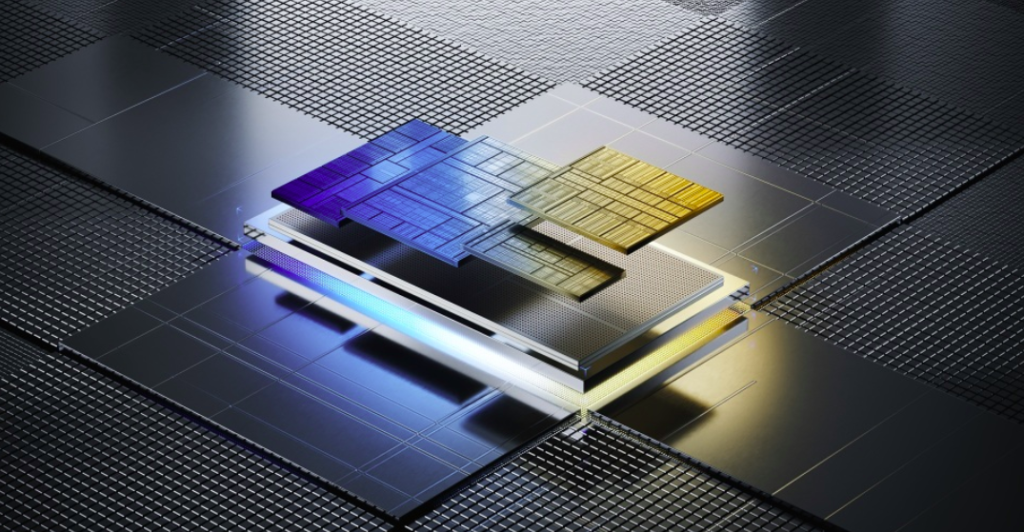

Intel is celebrating the debut of its Meteor Lake family of mobile CPUs with an event titled “AI Everywhere” today. With the launch of the new chip family, the business is taking a major step ahead by utilizing tiles rather than a monolithic design to create its CPUs. It also marks the company’s first CPU on the new Intel 4 process, which replaced the 7nm, demonstrating that it can transition to a new node without having to wait years for a transition. Eight new CPUs are being introduced, and three more will follow in 2024. By the time you read this, a large range of computers should have them available.
All things considered, Intel is releasing the Core Ultra 7 and Core Ultra 5 CPUs today; the “Ultra” designation refers to Meteor Lake. These chips have six performance and eight efficiency cores at their highest capacity, as predicted, and each SKU also has two low-power cores. At the top end, that translates to a processor with 16 cores and 22 threads and a maximum boost rate of 5GHz. Meteor Lake doesn’t flaunt about its core counts because it places a lot of emphasis on efficiency. This focus is demonstrated by the fact that every Meteor Lake CPU has two low-power and eight efficiency cores; hence, the only core count that varies between SKUs is the number of P-cores.

In summary, the company is releasing four Core Ultra 7/5 CPUs for its mainstream H-series and four additional CPUs in its ultra-thin laptop-focused U-series. The U-series chips only consume 15W of power, compared to the 28W rating of the H-series chips. The Ultra 7 and Ultra 5 CPUs found in both product lines are indicated by the letters H or U in their names to make it clear which CPU belongs where.
Apart from the CPUs mentioned above, Intel has three more in store for 2024: two additional 9W U-series chips and a flagship 45W Core ultra 9 CPU. There won’t be a Core Ultra 3 version because those will probably be rebranded 13th and 14th Gen chips.

The Core Ultra 9 is a peculiar CPU because it is the only portion of the Meteor Lake lineup rated at 45W, while the remainder of the H-series is rated at 28W. With the same number of cores, cache size, and iGPU configuration as the Core Ultra 7 165H, it is known as the Core Ultra 9 185H. We are left wondering why Intel even bothered with this SKU, though, given that it has a 50MHz higher speed on the Xe GPU and a 100MHz higher boost clock on its P-cores. What’s even more puzzling is that it won’t even be available at launch. It has now been confirmed that this chip was delayed, as previously reported.
Otherwise, efficiency, artificial intelligence, and the performance of its integrated GPU are Intel’s three main Meteor Lake advantages—pardon the pun. The AI capability of Intel’s inbuilt Neural Processing Unit (NPU) and gaming performance are heavily promoted by the company, suggesting that Meteor Lake outperforms its predecessors and rivals in both areas.
For instance, if true—and we don’t see any reason why it shouldn’t be—Intel claims that the Xe-based GPU in Meteor Lake can achieve up to two times the performance of the iGPU in Raptor Lake at 28W. Notably, the iGPU supports Intel’s XeSS upscaling technology, which the company claims can yield frame rates up to 39% higher—all on a thin and light laptop. Ray tracing is also supported by the iGPU in Meteor Lake, but enjoy it on a thin-and-light notebook.

Intel isn’t boasting about smashing benchmark records for pure computing power because that’s all based on TDP, which is 28W for the H-series. By using that measure, Intel claims that the Core Ultra 7 165H CPU has 11% more processing power than the 28W Ryzen 7 7840U mobile chip from AMD. Additionally, according to Intel, this CPU is more powerful than Apple’s new M3 chip at 28W. As previously said, Intel is primarily concerned with performance per watt with these chips, particularly in extremely light notebooks, so expectations need to be moderated while taking these things into account.
The NPU’s performance is a little more unclear because it appears Intel is marketing this hardware in anticipation of a time when “AI PCs” will be commonplace. It easily defeats AMD’s 7840U CPU and its 13th generation chips in benchmarks for programs like Stable Diffusion and DaVinci Resolve. It’s unclear, though, how future real-world AI applications will help the typical customer. AMD is also playing the “AI is everywhere” card, but mainstream customers haven’t seen it yet. By 2024, that might have changed.